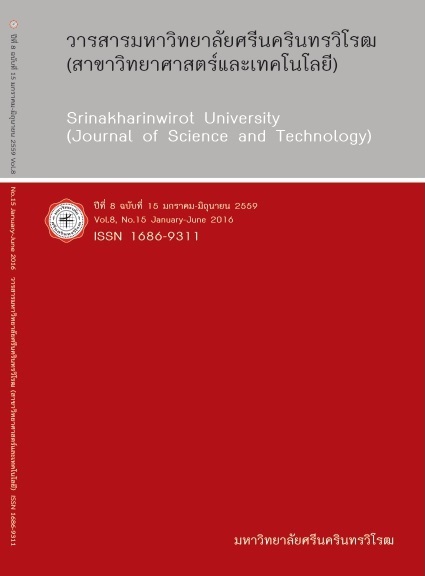การศึกษาและทดลองวัสดุผสมขี้เลื่อยไม้ยางพาราเพื่อใช้ในงานแกะสลักทดแทนไม้ THE STUDY AND EXPERIMENTAL COMPOSITE MATERIAL OF RUBBER TREE SAWDUST TO CARVING WOOD SUBSTITUTE MATERIALS
Keywords:
ขี้เลื่อยไม้ยางพารา วัสดุผสม งานแกะสลักไม้Abstract
บทคัดย่อ
การวิจัยครั้งนี้ มีวัตถุประสงค์ เพื่อศึกษาและทดลองการผลิตวัสดุผสม (Composites) ระหว่างวัสดุหลัก (Matrix) กับ วัสดุเสริมแรง (Reinfocement) ขี้เลื่อยไม้ยางพาราเพื่อใช้ในงานแกะสลัก เพื่อทดสอบคุณสมบัติทางด้านกายภาพของแผ่นวัสดุผสมขี้เลื่อยไม้ยางพารา เพื่อทดสอบการแกะสลักแผ่นวัสดุผสมขี้เลื่อยไม้ยางพารา และ เพื่อทดลองสร้างผลิตภัณฑ์ต้นแบบจากแผ่นวัสดุผสมขี้เลื่อยไม้ยางพารา
ประชากรและกลุ่มตัวอย่างที่ใช้ในการวิจัยครั้งนี้ ได้แก่ 1) กระบวนการผลิตวัสดุผสมจากขี้เลื่อยไม้ยางพารา (การผสมวัสดุหลักกับวัสดุเสริมแรงและการขึ้นรูปแผ่นวัสดุผสม) เครื่องมือในการวิจัยประกอบด้วย
1) แบบบันทึกผลการทดลองวัสดุผสม 2) เครื่องทดสอบคุณสมบัติทางด้านกายภาพของแผ่นวัสดุผสม 3) แบบประเมินผลการทดสอบแกะสลักแผ่นวัสดุผสม 4) แบบสอบถามผู้ซื้องานหัตถกรรมไม้แกะสลัก และการวิเคราะห์ข้อมูลใช้ค่าร้อยละ ค่าเฉลี่ย และค่าเบี่ยงเบนมาตรฐาน
ผลการวิจัยสรุปได้ ดังนี้
1. การวิเคราะห์และทดลองวัสดุผสม พบว่า การทดลองวัสดุผสมระหว่างวัสดุหลัก กับ วัสดุ
เสริมแรงขี้เลื่อยไม้ยางพารา โดยผลการทดลองมีส่วนสำคัญที่พบจำแนกเป็น 4 ประเด็น คือ 1) ได้สูตรวัสดุผสมจำนวน 3 สูตร ได้แก่ วัสดุผสมสูตร CM1 CM2 และ CM3 (กาวลาเท็กซ์ : ปูนปลาสเตอร์ : ขี้เลื่อยไม้ยางพารา : น้ำ : โซเดียมเบนโซเอต : สีฝุ่น) 2) ได้แผ่นวัสดุผสมสูตร CM1 ขนาดความกว้าง 29.85 ซม. ความยาว 39.85 ซม. ความหนา 22 มม. สูตร CM2 ขนาดความกว้าง 29.75 ซม. ความยาว 39.75 ซม. ความหนา 21 มม. และสูตร CM3 ขนาดความกว้าง 29.70 ซม. ความยาว 39.70 ซม. ความหนา 20 มม. 3) ผลการทดสอบคุณสมบัติทางด้านกายภาพของแผ่นวัสดุผสม พบว่า วัสดุผสมสูตร CM1 มีแรงดัด (27.50 ksc.) และความแข็ง (0.56 HB.) มากกว่า สูตร CM2 ซึ่งมีแรงดัด (24.40 ksc.) และความแข็ง (0.53 HB.) ในขณะที่ สูตร CM3 มีแรงดัด (16.93 ksc.) และความแข็ง (0.61 HB.) 4) ผลการทดสอบแกะสลักแผ่นวัสดุผสม พบว่า วัสดุผสมสูตร CM1 ( =2.35) และ สูตร CM2 ( =2.40) โดยภาพรวมมีความพึงพอใจอยู่ในระดับพอใช้ และสูตร CM3 ( =3.00) โดยภาพรวมมีความพึงพอใจอยู่ในระดับปานกลาง
2. การประเมินผลผลิตภัณฑ์ต้นแบบ พบว่า ผู้เชี่ยวชาญด้านการออกแบบผลิตภัณฑ์ ผู้ผลิต และผู้จำหน่ายงานหัตถกรรมไม้แกะสลัก มีค่าเฉลี่ยความพึงพอใจอยู่ในระดับมาก รายการข้อที่ประเมินความพึงพอใจอยู่ในระดับดีมาก คือ การนำวัสดุเหลือใช้มาเพิ่มมูลค่าและเป็นมิตรต่อสิ่งแวดล้อม ( =4.53) และข้อที่ประเมินความพึงพอใจอยู่ในระดับมาก 3 อันดับแรก คือ สามารถนำไปใช้งานได้ (ประดับตกแต่ง/เป็นของฝาก) และความเหมาะสมในการเลือกใช้วัสดุทดแทนไม้ ( =4.40) สามารถนำมาเป็นผลิตภัณฑ์ OTOP ได้ และโดยภาพรวมท่านพึงพอใจกับผลิตภัณฑ์ ( =4.33) ความสวยงามของผลิตภัณฑ์ (ลวดลายและรูปแบบ) และจำหน่ายได้ในท้องตลาด ( =4.20)
Abstract
The research aimed to carry out an experiment on the production of composite objects formed by matrix and reinforcement materials made from rubber tree sawdust to carving, to test the physical properties and graving of the composite material, and made prototypes. The population and the sample were 1) the production of composite materials from rubber tree sawdust. (mixing of matrix and reinforcement materials, and forming). The data were collected by 1) the results recorded material.
2) composite material tests use physical properties and engraving plate material, and 3) using questionnaire for handicraft buyers. The data were analyzed by percentage, mean and standard deviation.
The results were as follows:
1. The analysis and the experimental results showed that 1) three formulas were obtained: CM1, CM2 and CM3 formulas - Latex adhesive, plaster, rubber tree sawdust, clean water, sodium benzoate and iron oxide. 2) sheets of the composite materials CM1 of 29.85 cm. x 39.85 cm. x 22 mm., CM2 of 29.75 cm. x 39.75 cm. x 21 mm. and CM3 of 29.70 cm. x 39.70 cm. x 20 mm. 3) testing the physical properties of the composite material showed that CM1 formula a bending strength (27.50 ksc.) and hardness (0.56 HB.) than CM2 a bending strength (24.40 ksc.) and hardness (0.53 HB.) while CM3 a bending strength (16.93 ksc.) and hardness (0.61 HB.) were obtained, 4) testing the engraving plate material CM1 formula ( =2.35) and the second ( = 2.40) were at a fair level while the third
( = 3.00) was medium.
2. The sample product assessment showed that the overall satisfaction of the product design experts, manufacturers, and handicraft sellers was at a very good level is waste of adding value, and environment friendly ( =4.53), the rate of satisfaction was at a much level as follows: the first, can be used (accessories/souvenirs), and appropriate choice of wood substitute materials ( =4.40); the second, can be taken as OTOP products, and overall satisfaction ( =4.33); the third, beautiful appearance (patterns and style), and being marketable ( =4.20)
Downloads
Published
How to Cite
Issue
Section
License
Srinakharinwirot University Journal of Sciences and Technology is licensed Under a Creative Commons Attribution-NonCommercial-NoDerivs 4.0 International (CC-BY-NC-ND 4.0) License, Unless Otherwise Stated. Please Read Journal Policies Page for More Information on Open Access, Copyright and Permissions.



